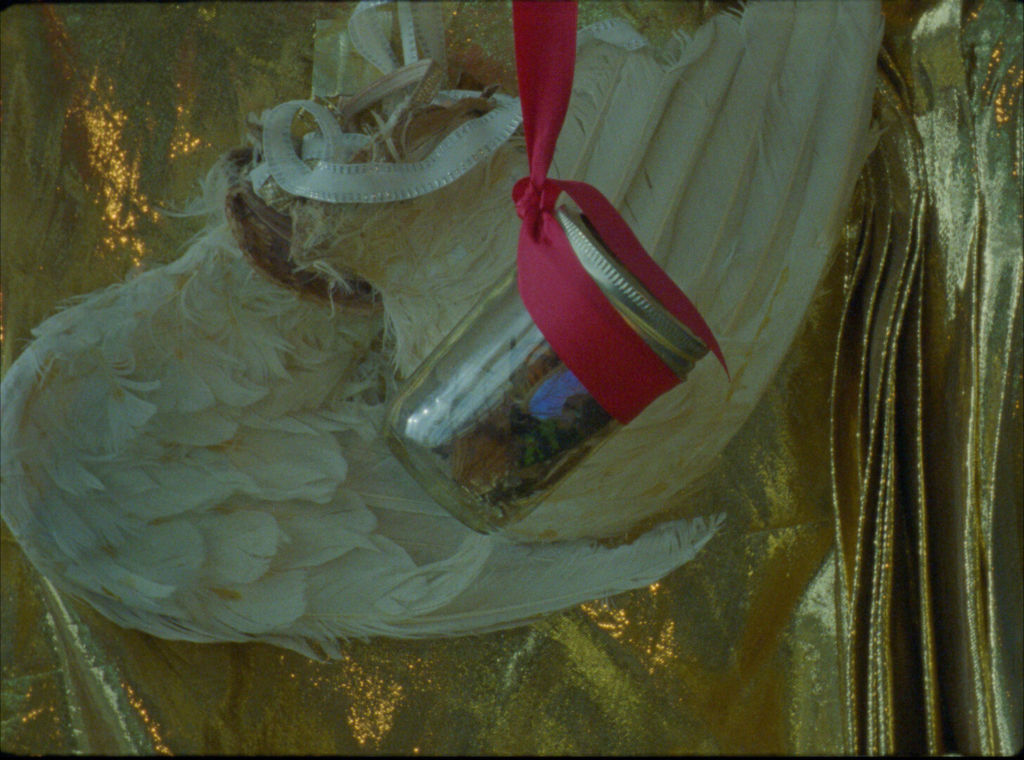
On Volya
On Volya: Filling in the Frescoes (2023) is a postcript to Kyiv Frescoes (1966) by filmmaker Sergei Parajanov (1924-1990). His film was conceived of as part of an “industry-wide effort to commemorate the 20th anniversary of the Soviet Union’s victory” in the Second World War. Kyiv Frescoes heralded Parajanov’s “surrealist and balletic style that would become the directors signature,” as seen in his later masterpiece Colour of Pomegranates (1969). Kyiv Frescoes was deemed pacifist, provoking an anti-war message, and was furthermore critiqued as semi-autobiographical, resulting in its suppression by Goskino, the central state film committee in Moscow. During Glasnost or the Soviet Thaw (1986–1991), a period that saw intentional efforts towards institutional transparency and freedom of information, 15 minutes of remaining rushes were re-discovered in a film canister labelled “Diploma Film.” On Volya imagines the unearthing of a second.
Central to this moving image work is a meditation on the proto-slavic term: воля (volya), a lexical lacuna that describes the will and desire to exist beyond societal constructs; to be wildly emancipated. A slippery term, volya is described by Russian mystic writer Nadezhda Teffi (1872-1952) in her recently translated text Other Worlds: Peasants, Pilgrims, Spirits, Saints. Teffi chronicles Liberté as a person who finishes work early, takes their hat off and is free to read the newspaper; to sit and think in the café. They are free because they have abided by the rules of society. In contrast, Teffi describes Volya as a person who takes their hat off and runs into the field, blinded by the sun as they enter into an unbroken horizon. In On Volya’s opening scene, a figure appears to float through a forest; a guise that requires being high on the toes, with knees bent and stuck together; the hips and torso unnaturally controlled. It is anything but freeing. In the following shot, the figure escapes this muscle memory in a literal attempt to volya as she runs into the remains of the ancient Caledonian Forest. The film begins in an acknowledgement that volya itself, to flee into an unbroken horizon, the densest of forests, leaves one in solitude.
On Volya considers reverence and regeneration across social, political, and spiritual planes. It punctures idyllic façades of an eternally abundant nature, revealing how this ethos perpetuates the accelerated decline of our ecosystems today. If volya is indulged in sparingly, it is an essential space for rest, articulation, slowing down, and regaining the energy that can bolster reflective action. The film’s supernal crescendo depicts one such space by ascending the horizon and entering into a blue sky. It is the blue of Chernobyl’s velvety glow; Natalka Husar’s tubes of toxic Glasnost-market cobalt; Derek Jarman’s last words; Chantal Akerman’s From the East; Kandinsky’s symphonic ecstasy. It is the elation of altitude, the raging sea, morpho’s span, lover’s eyes.
Blue is a loss of consciousness,
a sense of self,
it is falling
– but which way is up?
Revisiting Parajanov’s Kyiv Frescoes at this particular time is especially poignant as it sheds light on cyclical attempts to erase Ukrainian culture, occurring again today in the Russo-Ukrainian war. Working through a series of artistic interventions in On Voyla, what is missing is filled in with what is geographically available. The finale is a golden affair that draws parallels between the Fontaine Druzhba Narodov (Friendship of Nations Fountain) in Moscow, Russia and the Doulton Fountain in front of the People’s Palace in Glasgow, Scotland. On Volya: Filling in the Frescoes alters these symbols of soft power through an action led by ritual; the cleansing of assimilation. Breaking the fourth wall, I invite you to do the same.
Note: All quoted descriptions are original words by the Dovzhenko Studios. This is where the negative of Kyiv Frescoes is housed today, in the Dovzhenko National Centre in Kyiv. The Centre is Ukraine’s largest film archive, which is at great risk as a consequence of the current Russian invasion.
